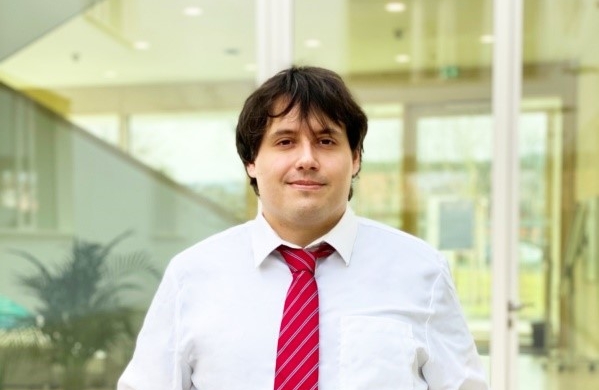From Darmstadt to Princeton and back again in the name of material science
Interview with Dr. Sebastian Klemenz, young scientist at Fraunhofer IWKS and funded by the Fraunhofer Attract program
Mr. Klemenz, you have headed the "green²ICT" research group at Fraunhofer IWKS since February 2021 on the topic of sustainable materials for information technologies made from secondary raw materials. This includes functional materials, but also novel quantum materials. Can you explain what makes these materials special?
Quantum materials are materials that have very special physical properties. These can be electronic properties such as particularly good conductivity or magnetism. Many of these materials are already known, of course, but how exactly their special properties come about and how these effects can be used for various applications has not yet been comprehensively researched. In addition, new materials and classes are constantly being added.
And how does the aspect of sustainability come into it?
Sustainability does indeed play a major role in the "green²ICT" project. Many of the quantum or functional materials mentioned above are essential for current and future high-tech applications: Magnets in electric motors, semimetals in information technology, or catalysts for hydrogen production. These materials often contain rare and valuable raw materials. It is therefore a question of recycling these high-performance materials in such a way that their special properties are retained.
How do you start?
We start with a new way of looking at the materials and their properties. We analyze not only their components, but also the interactions between them and their topology. This is one of the basic ideas of quantum materials, which captures how materials are built up inside. If we understand materials better, we can turn old materials into new forms without compromising their function. Applied to the field of sustainability, this means that we can, for example, make new magnets from old ones that are just as strong. Ideally, we can then use the so-called recyclates (i.e. the old material) to efficiently produce new materials for production in industry. So far, one of the major challenges in recycling is that materials change very quickly, especially in the high-tech sector: what was used 10 years ago may no longer be used for new products today because other materials with better properties have been found. And this is where we come in: through a good understanding of the composition and functioning of materials, we want to obtain recyclates that meet the requirements of new materials. That's why it's also important to know where the journey is headed. Quantum materials will be an important part of future technologies.
You mentioned magnets - what might that look like in concrete terms?
With magnets, the microstructure is quite crucial. Only if we find a way to model the structure exactly according to our ideas in the recycling process will we get a good recyclate. The research area of magnetic materials at Fraunhofer IWKS has already achieved very good results in this area. One challenge that we would like to tackle together as part of the Attract program is the shape flexibility of the recyclates. For example, we are working on producing a powder from old magnets that can be shaped into any desired form using additive manufacturing (3D printing). This would be a significant advantage for the industry.
Sounds quite simple....
Yes, in theory [laughs]. Although there are already initial positive research results here, too.
Fraunhofer is funding your research as part of its Attract program for outstanding young scientists. In fact, your last position was at one of the world's most renown universities, Princeton. Why did you decide to do research in Germany again?
There are several reasons. I had an extremely productive and enjoyable time at Princeton, which I wouldn't want to miss. It was an inspiring working environment for me, and the close connection between physics and chemistry brought me closer to the topic of quantum materials. However, I knew from the start that I only wanted to stay for a limited time, and I was happy to return to my home region afterwards. It's great to be able to set up my own group here now, and with a research topic that matches my convictions.
And what conviction is that?
I am a solid-state and materials chemist with a passion. The connection between structure and property has always been the guiding principle in my work on different classes of materials. However, I am also interested in the big picture. As a doc-torand, I was a fellow of the Darmstadt Excellence Graduate School Energy Science and Engineering. The various aspects combined in this group of young scientists ranged from detailed physics of individual materials to technical implementation and the broader field of sustainability assessment. This has had a great impact on me. I am pleased to have found in Fraunhofer IWKS a place where I can work on projects that link the performance of materials with sustainability by incorporating ecological, economic and social aspects into the material design process.
Mr. Klemenz, thank you very much for the interview!
The interview was held by Jennifer Oborny from the press and media department at Fraunhofer IWKS.
Vita Dr. Sebastian Klemenz:
Sebastian Klemenz studied chemistry at the Technical University of Darmstadt and was a scholarship holder at the Darmstadt Graduate School of Excellence Energy Science and Engineering (GS ESE). In 2017, he completed his PhD as Dr. rer. nat. at the Technical University of Darmstadt. After graduation, he worked as a research associate at the Max Planck Institute for Chemical Physics of Solids in Dresden and at Princeton University (NJ, USA). Since February 2021, he has been working at Fraunhofer IWKS in the area of magnetic materials as part of the Fraunhofer Attract funding program.
